One; that the officer in charge of commissioning posters for the Office of War Information rejected Rockwell's proposal because he was "an illustrator" and the department had decided to use only fine artists, "real artists", for their poster assignments during WWII.
Two; that in the opinion of Saturday Evening Post editor Ben Hibbs, Norman Rockwell had created "great art" in the making of 'Freedom of Speech' and 'Freedom of Worship' - although Hibbs felt Rockwell would disagree because "he has always modelled himself an 'illustrator' with no pretensions of fine art."
The "pretensions of fine art"... "real artists"...
How the world perceives fine art vs. illustration and how artists perceive themselves in their capacity as visual communicators continues to frustrate and fascinate me.
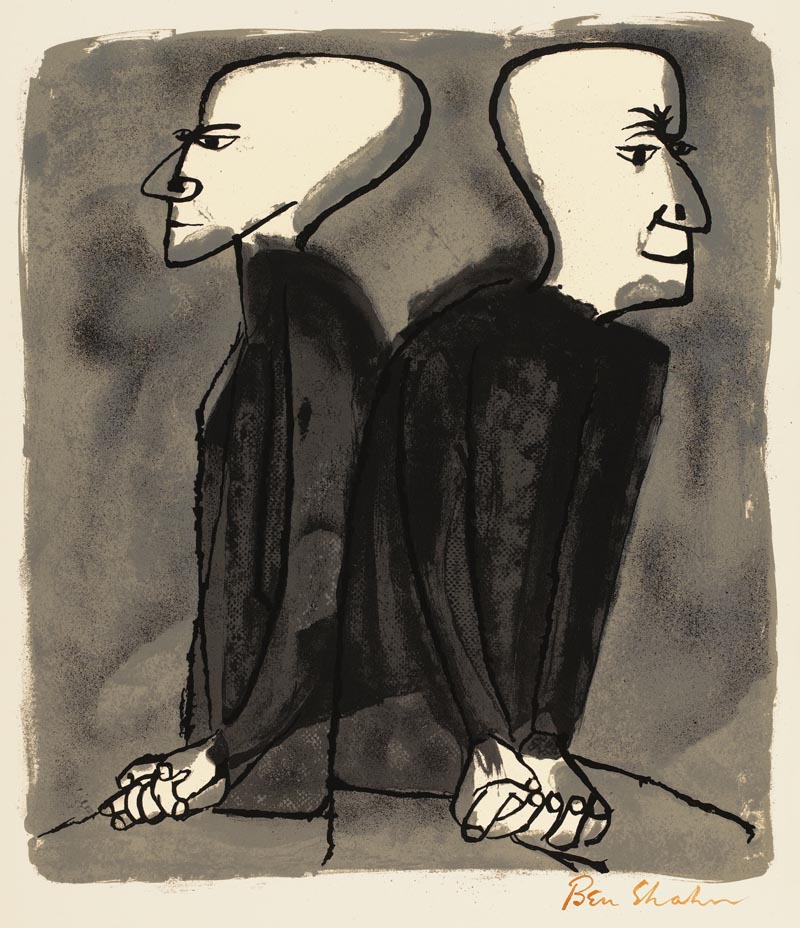
Based on the excellent, thought-provoking discussion that transpired on the last Ben Shahn post (and which I hope will continue on this one) many people, like the officer at the War Information department, have too narrow a definition of fine art and illustration and their relative merits.
It strikes me that most people don't 'get' what "real art" is or who "real artists" are. It strikes me that many people seem to have some pretty unrealistic expectations of both art and artists and the relative merit and quality of their work.
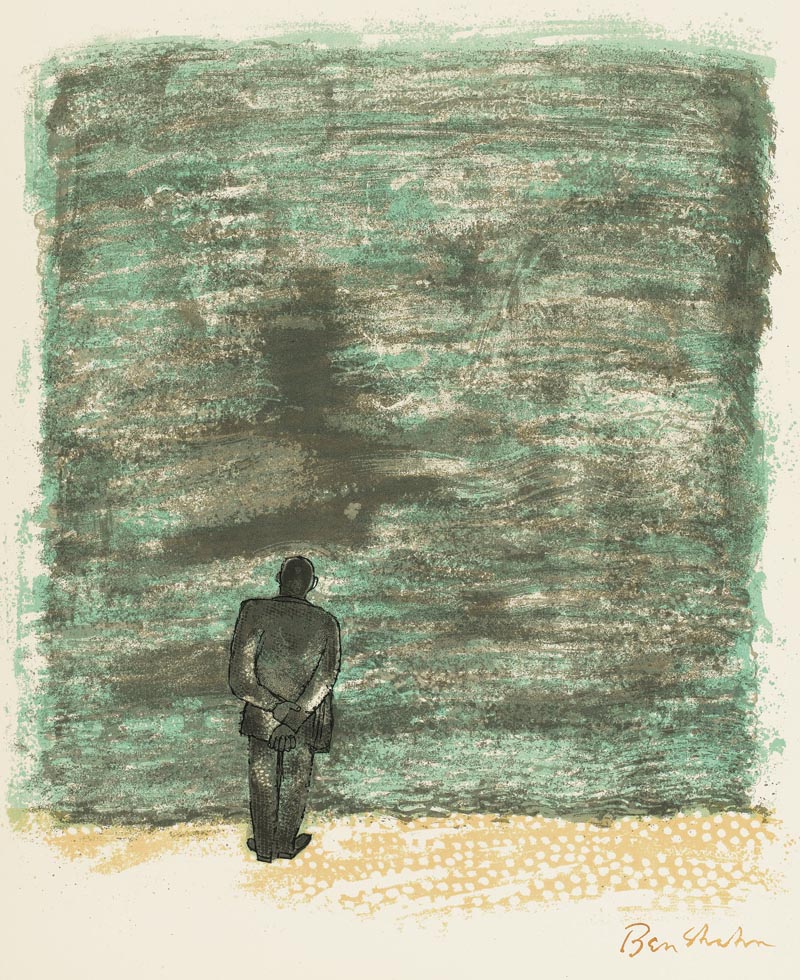
I remain unsure if Ben Shahn considered himself a fine artist or an illustrator - despite all I've read by and about him - or, quite frankly, if it would even have mattered to Shahn.
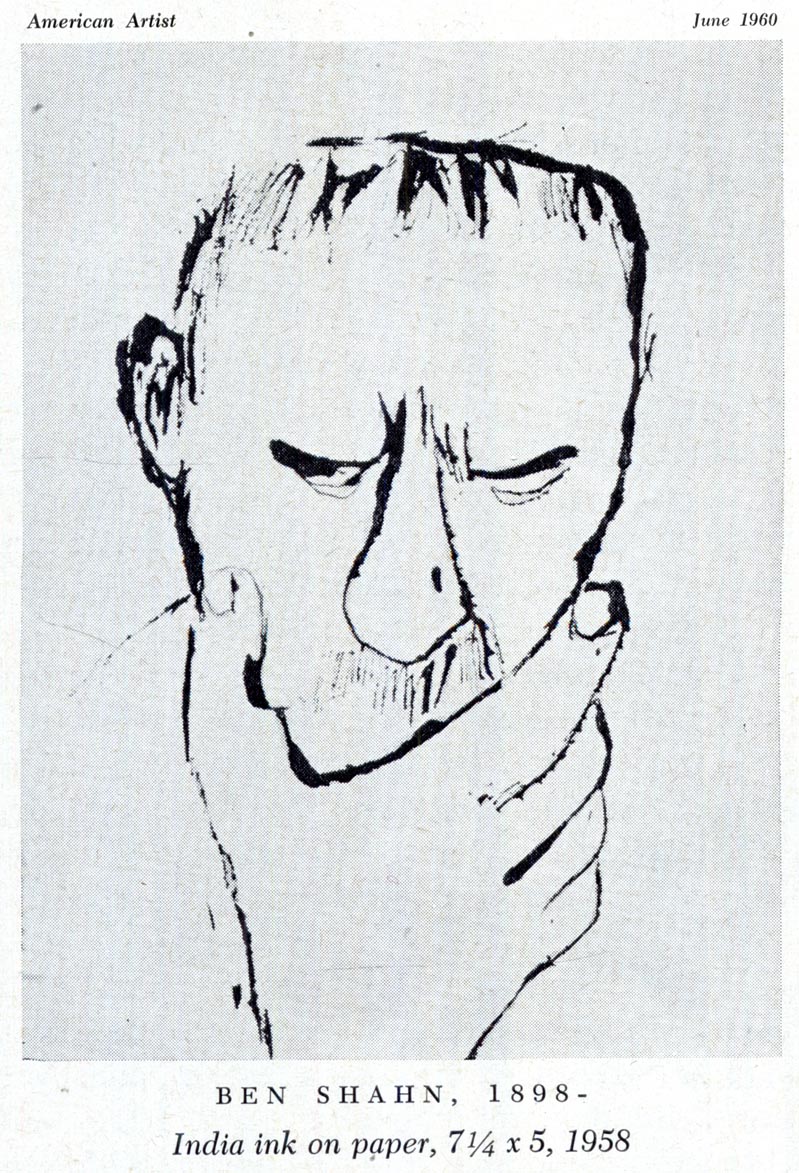
I do know that he considered himself a realist (no doubt Norman Rockwell considered himself one as well) and that realism was a 'trending topic' in both fine art and illustration during the mid-20th century.
The January 1953 issue of Art Director & Studio News offered both an observation and a prediction about trends in commercial art at that time...
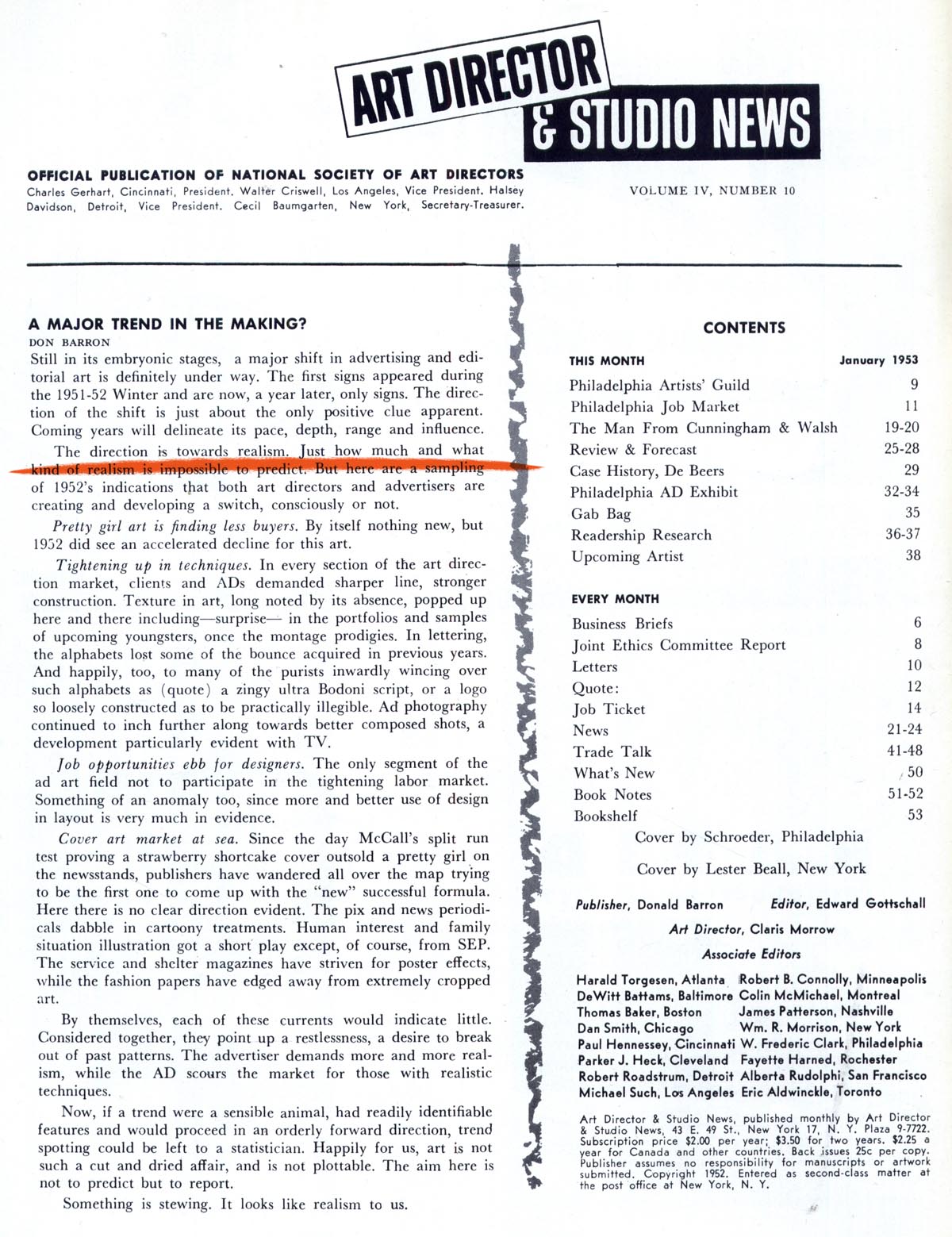
... a trend toward realism.

Further on in that same issue, a survey of industry professionals in major art markets across America confirmed the editors' opinions...

Illustration was becoming increasingly realistic.

Later that same year Ben Shahn wrote an article in Look magazine wherein he challenged the accepted definition of what qualifies as "realism."
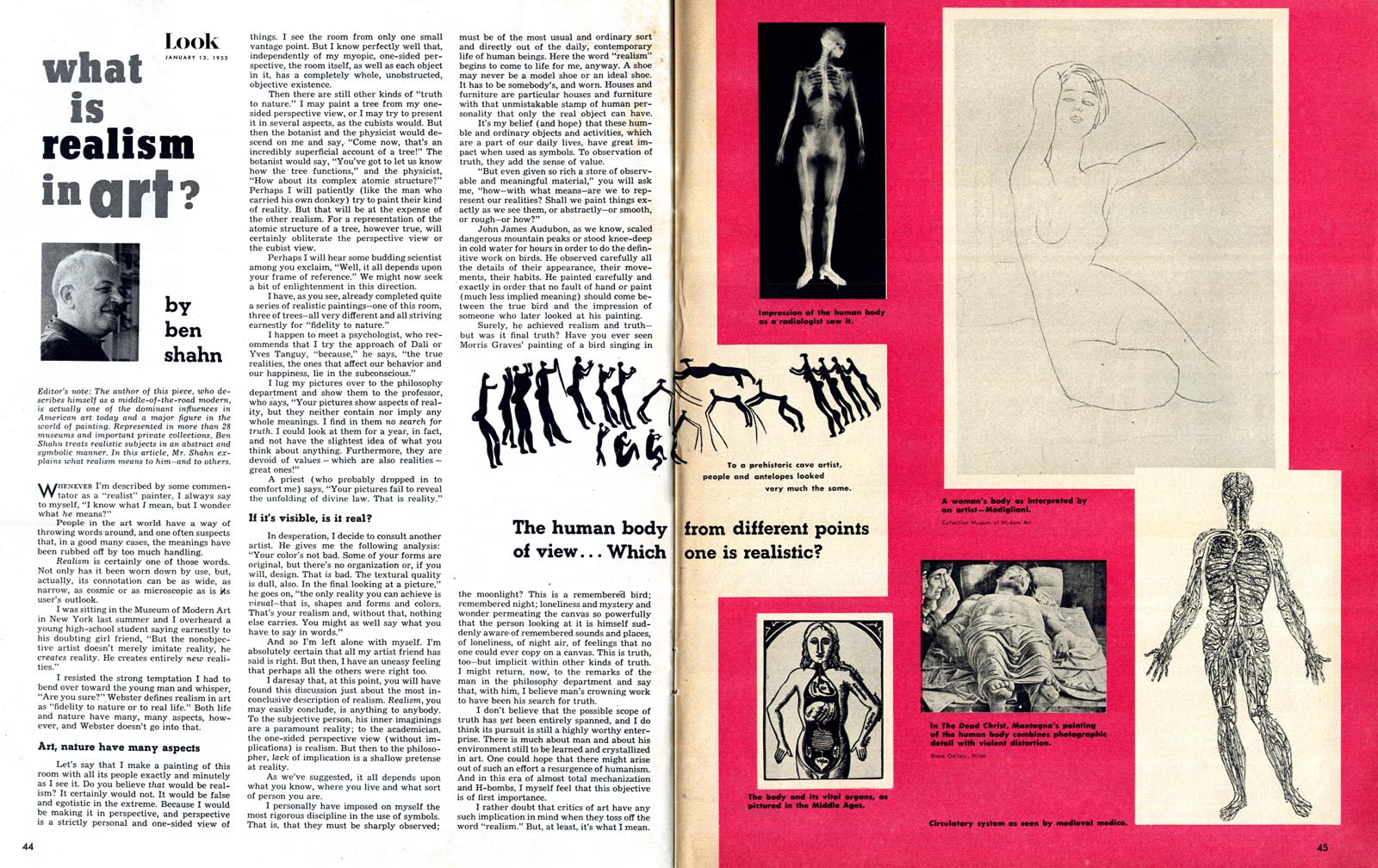
As requested by one reader, here is that article in its entirety. I think it conclusively describes Shahn's position on the subject of realism.

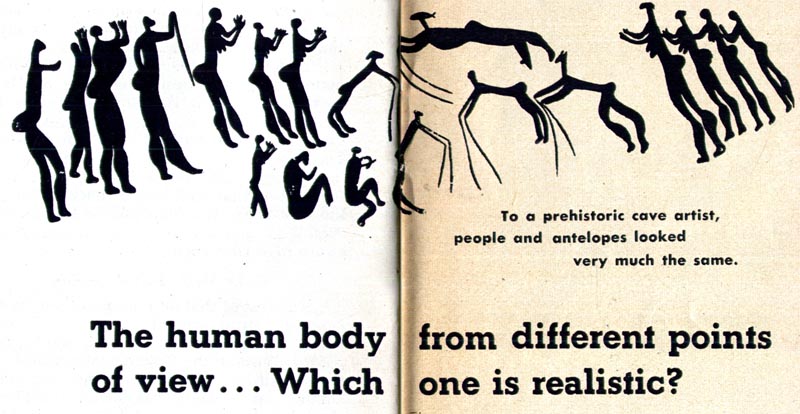

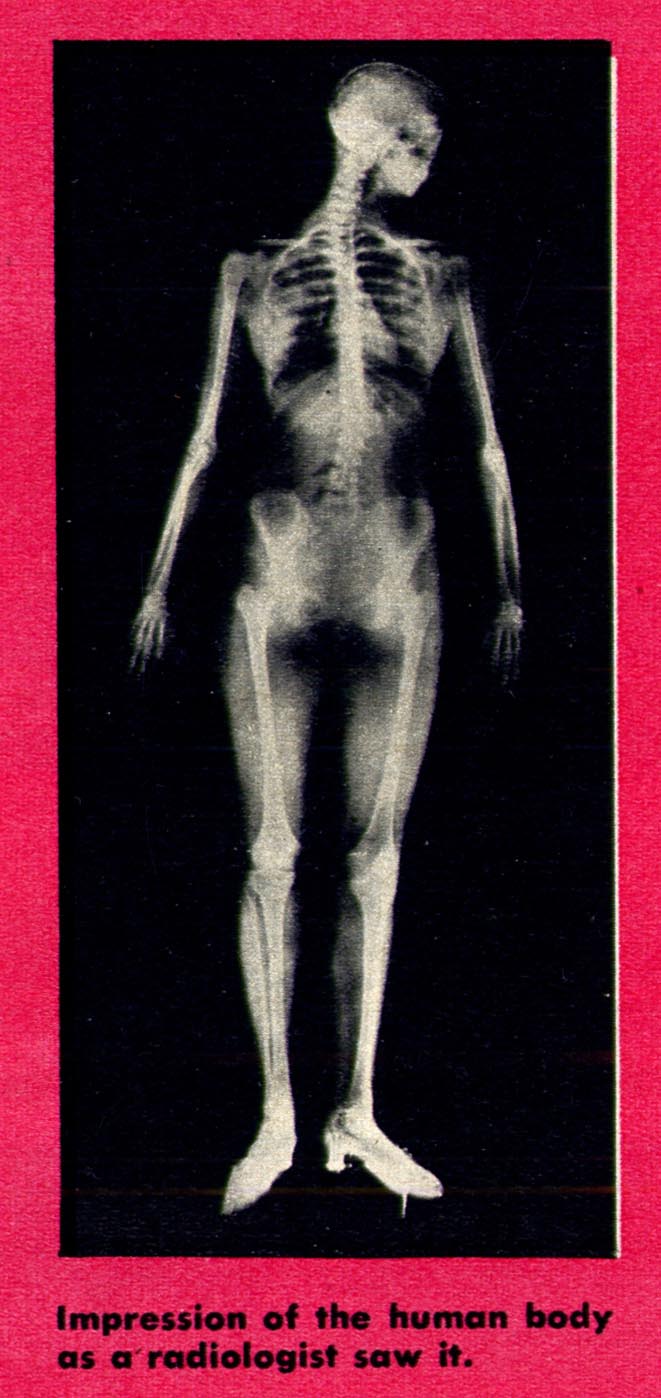

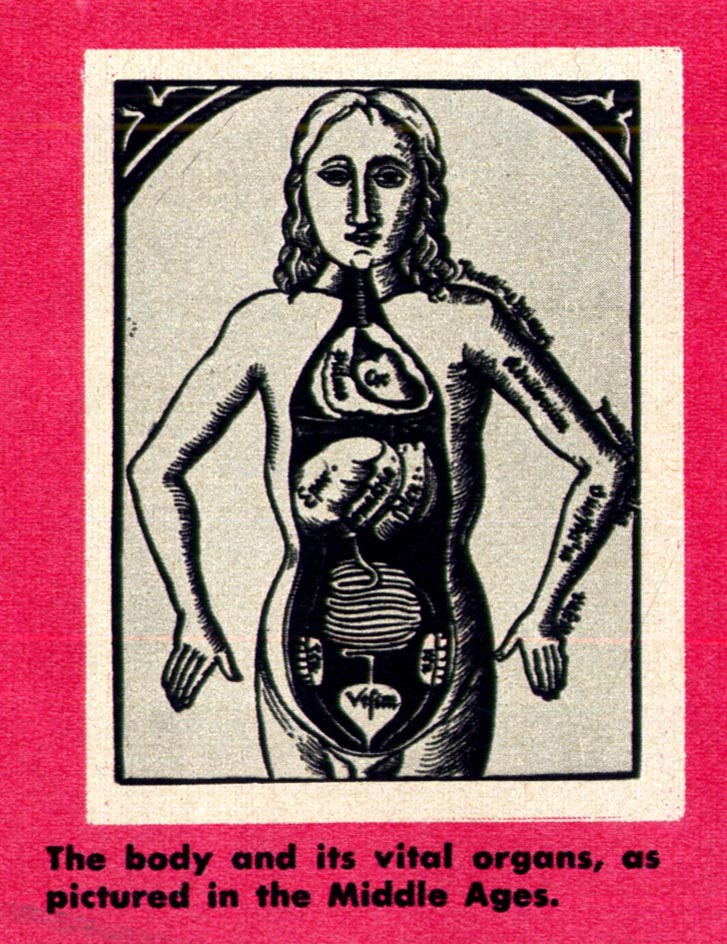
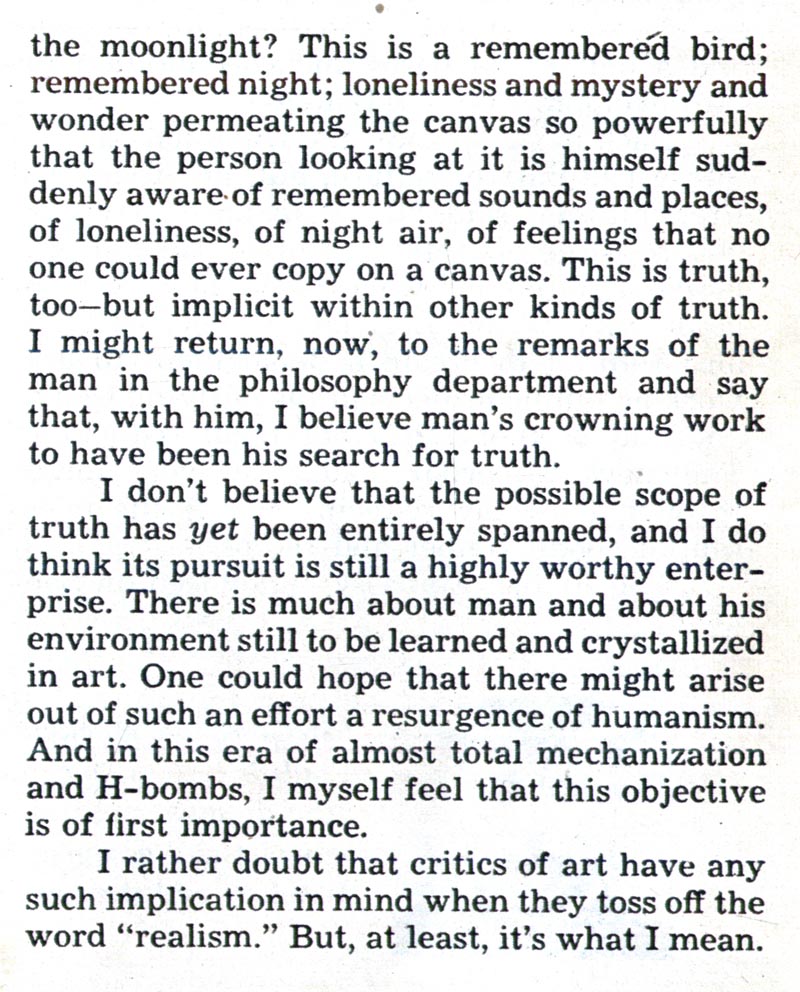
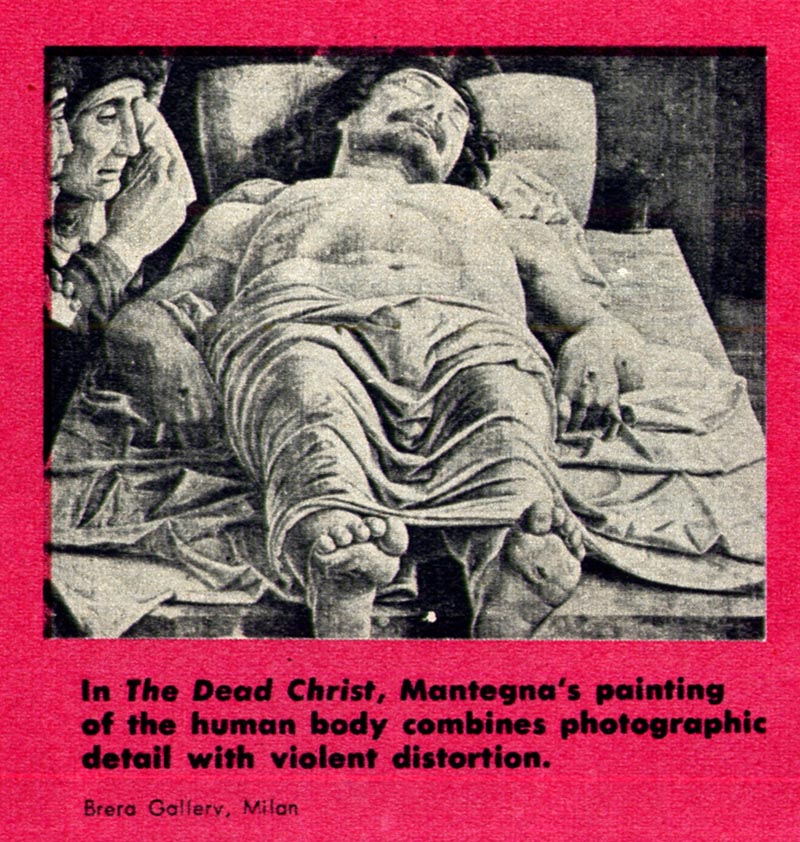
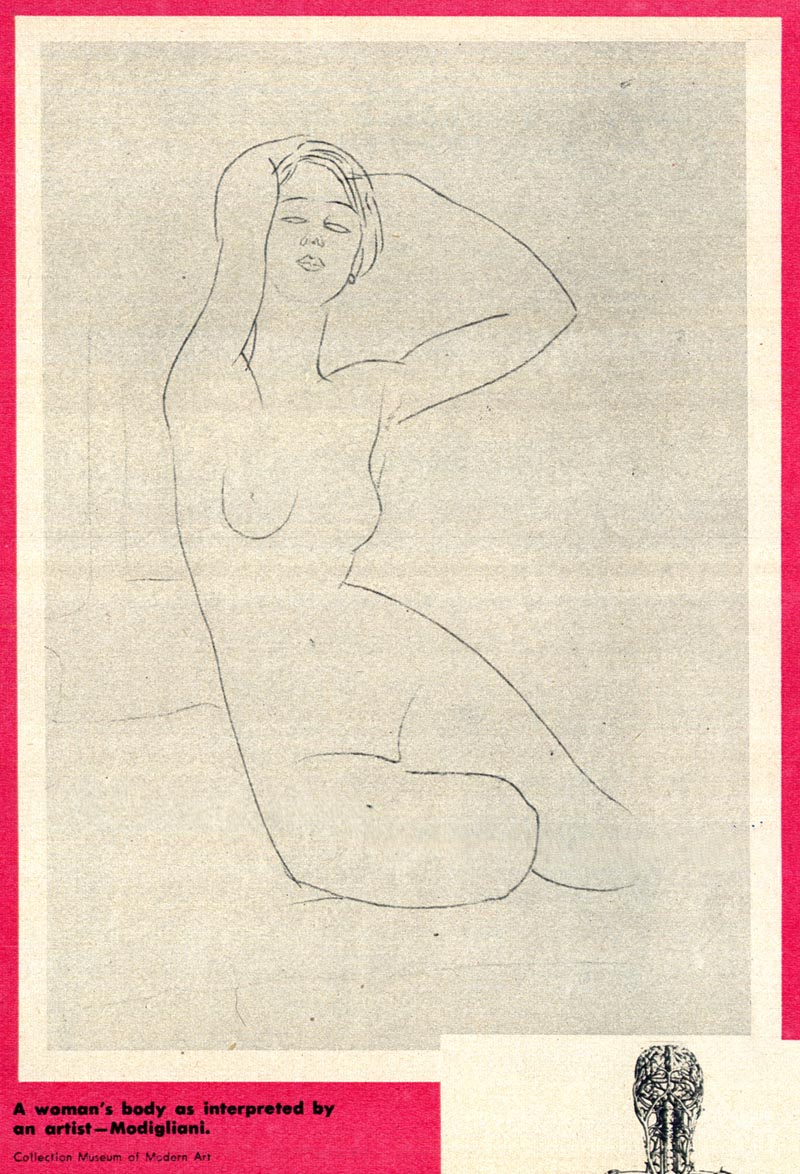
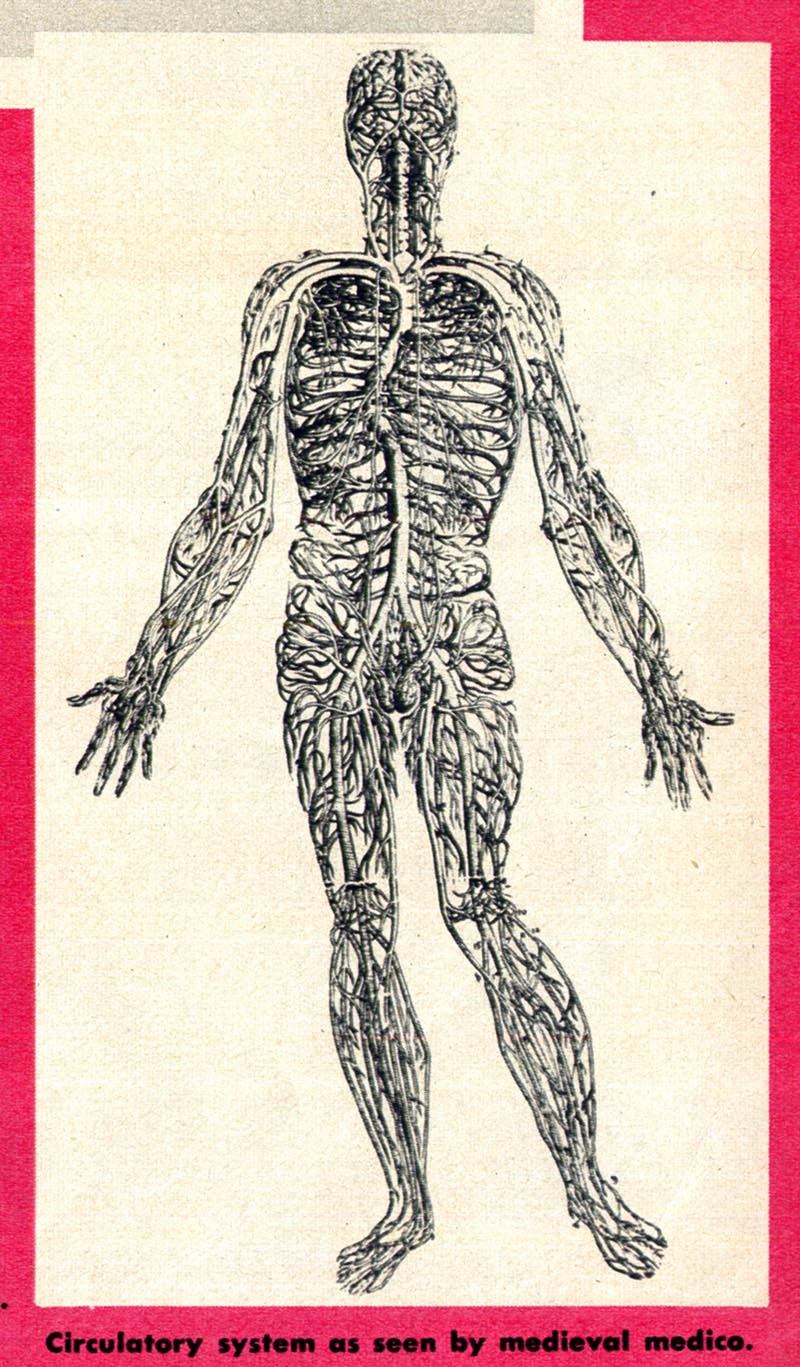
To summarize I'll quote Bill Koeb from the previous Ben Shahn post's comment section: "Before there were lenses, and long before there were cameras, what was considered "real" was very different. Realism is what you draw, not how you draw."
The following year, in Life magazine, Shahn's work was the subject of a major multi-page, full-colour article. If there was any doubt that Ben Shahn was a driving force in American art at that time, the glowing description of Shahn stature in both the Look and Life magazine articles should put them to rest.
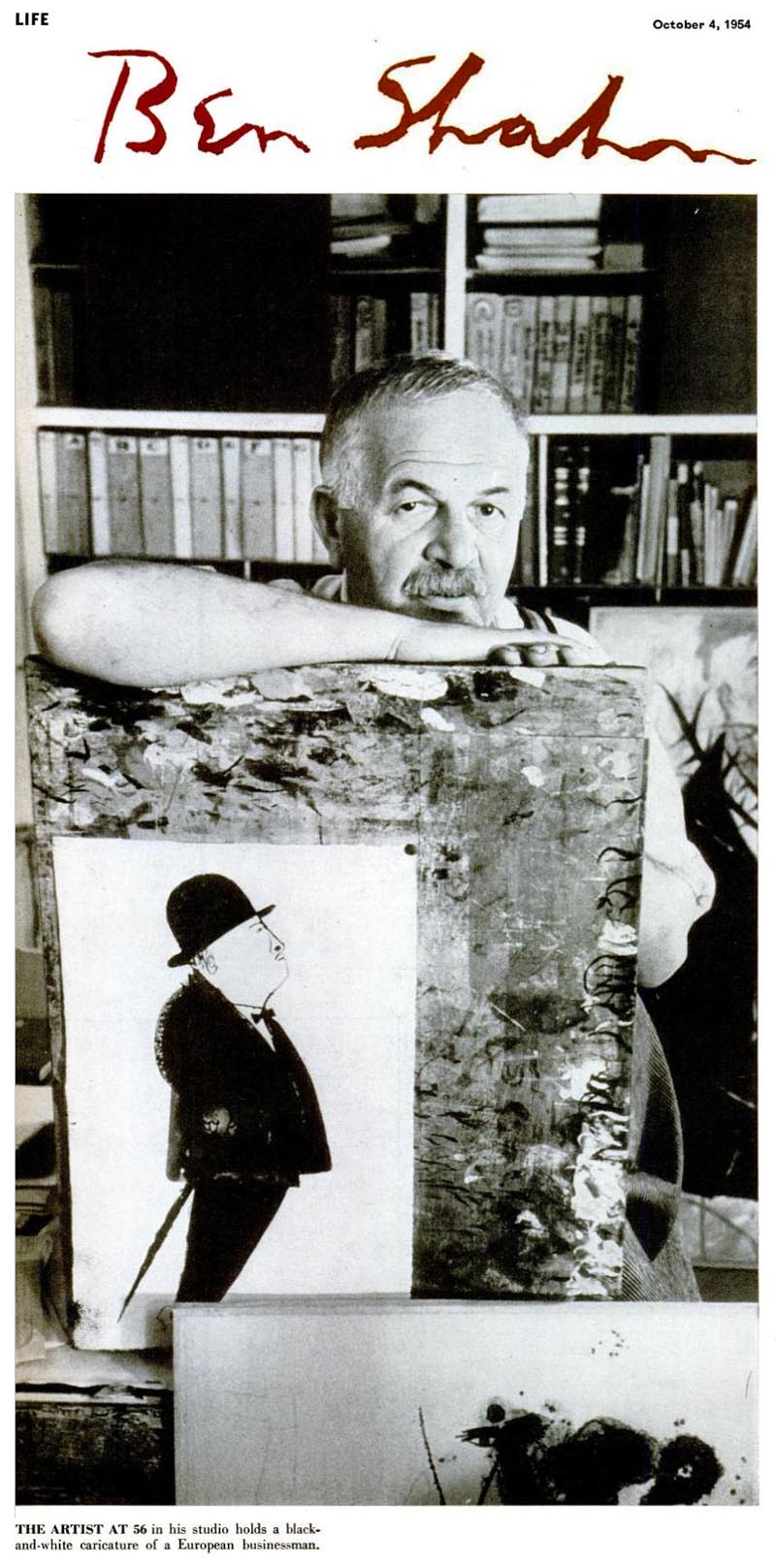
I find it particularly amusing that Shahn's work is described as "too photographically realistic"!


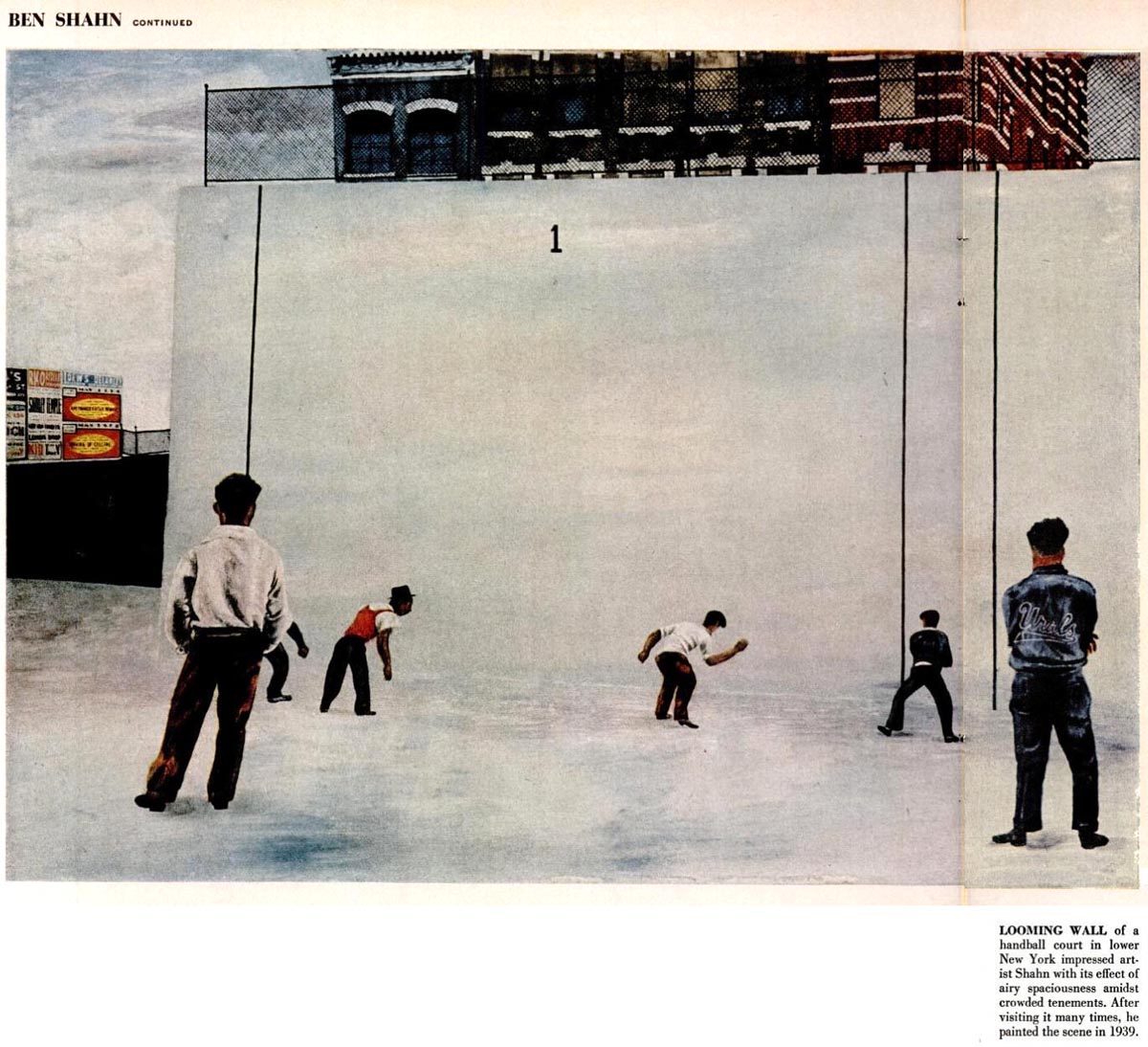
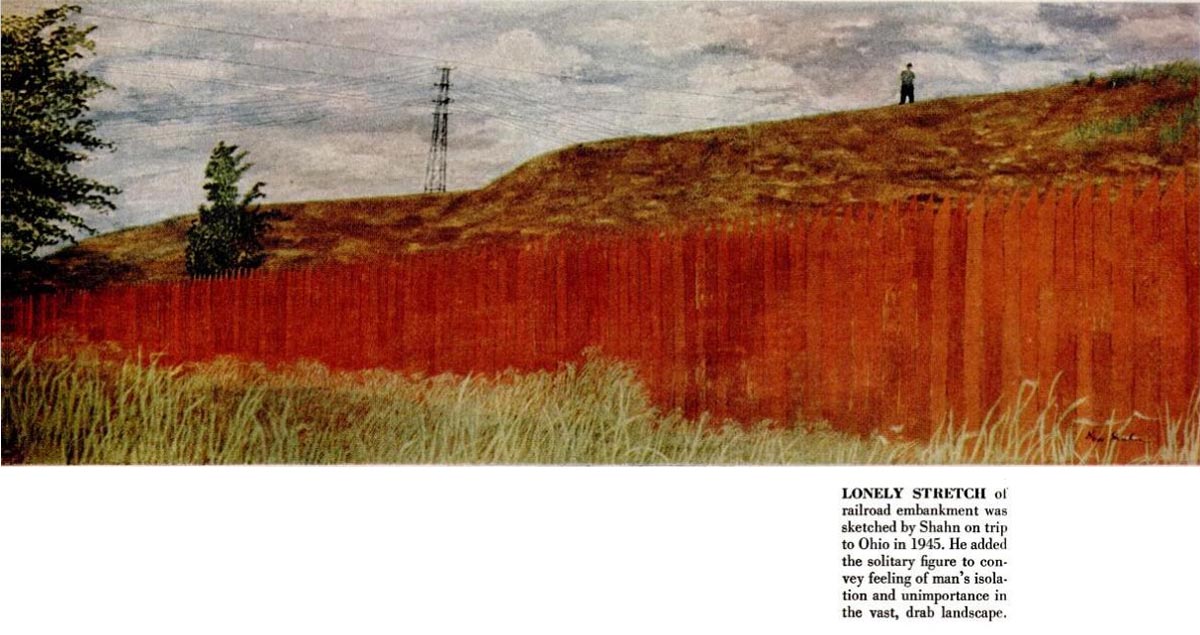
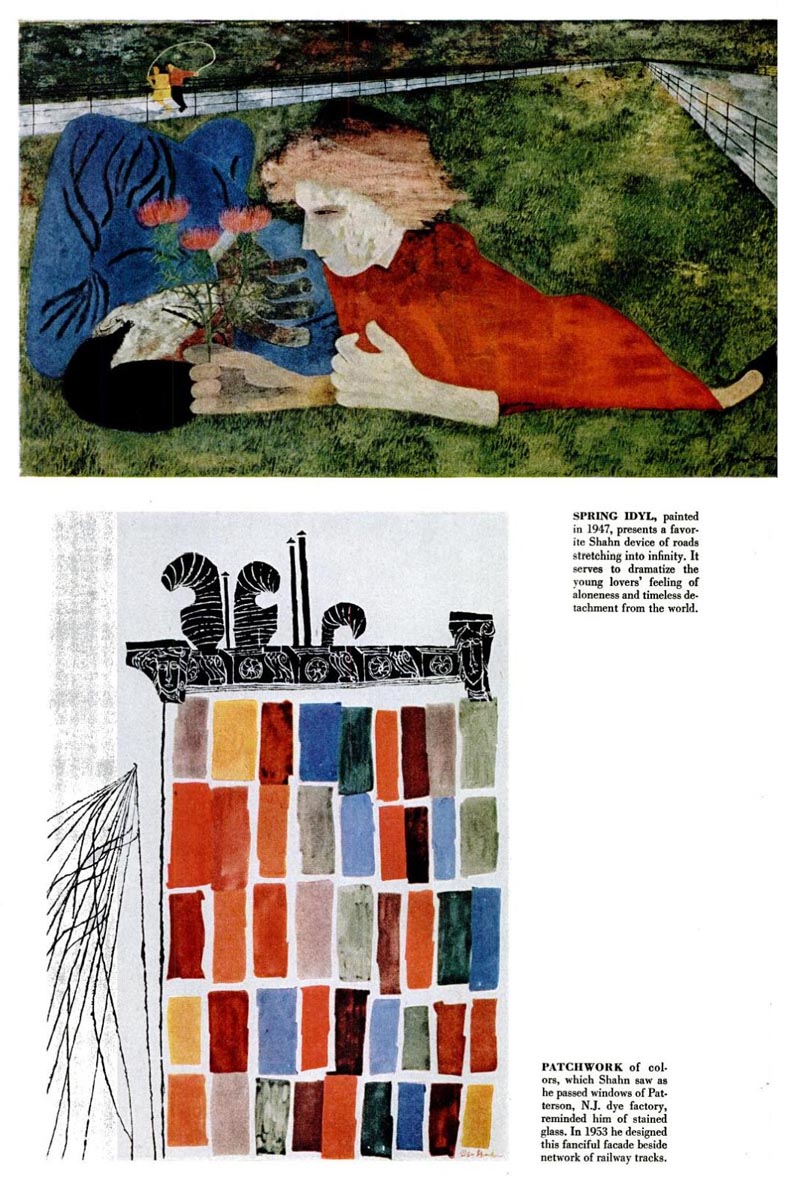

Readers who participated in last week's discussion on Ben Shahn shared so many interesting perspectives. Here are a few more that came to me via personal emails -- and then a few thoughts of my own...
Anita Virgil, whom I quoted in last week's Ben Shahn post sent this note:
"What a fantastic writeup on Ben Shahn you give your readers! But I must address those Doubting Thomases out there who would denigrate or question Shahn’s different approach to expressing emotion via design and utter simplicity, I refer them to his own words from his classic, The Shape of Content, (Vintage Book, 1957) -- a must for every artistic individual to absorb."
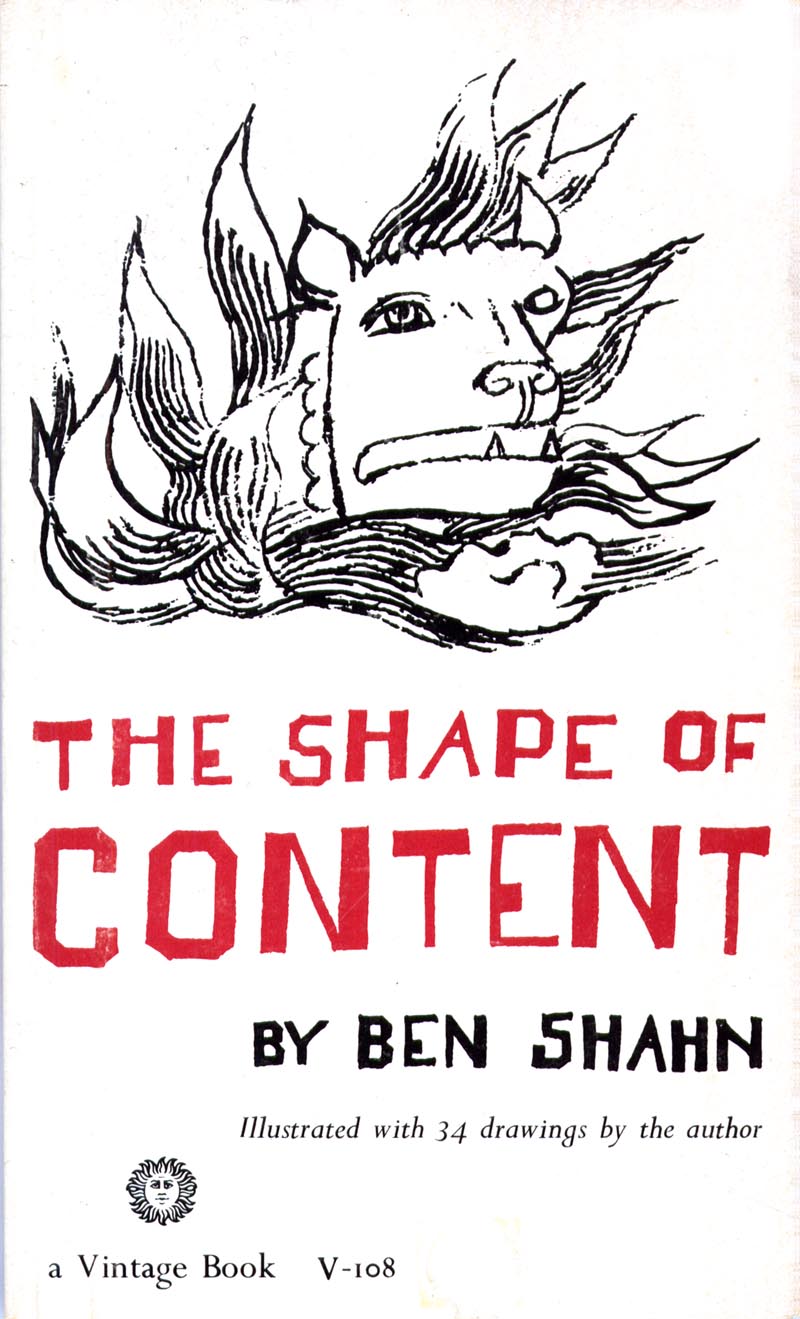
"They appear in his section “On Nonconformity” p. 88:"
“But it seems to be less obvious somehow that to create anything at all in any field, and especially anything of outstanding worth, requires nonconformity, or a want of satisfaction with things as they are. The creative person -- the nonconformist — may be in profound disagreement with the present way of things, or he may simply wish to add his views, to render a personal account of matters.”

Contrasting that viewpoint, Tom Watson sent the following:
"Your Ben Shahn post fired up an interesting and varied viewpoint on his influence and the '50s, '60s illustration scene. It was quite controversial even when I was in art school. Ben Shahn was either loved and embraced or hated and scorned. I think his simplicity of composition and unusual point of view in these examples are worthy of the influence they generated, but some of his stuff was too crude and primitive looking for my personal taste in illustration technique. IMO there needed to be and was a separation between fine arts and illustration, even though they began spilling over into each other's territory. Illustration required some restriction and control in order to communicate to all targeted viewers."
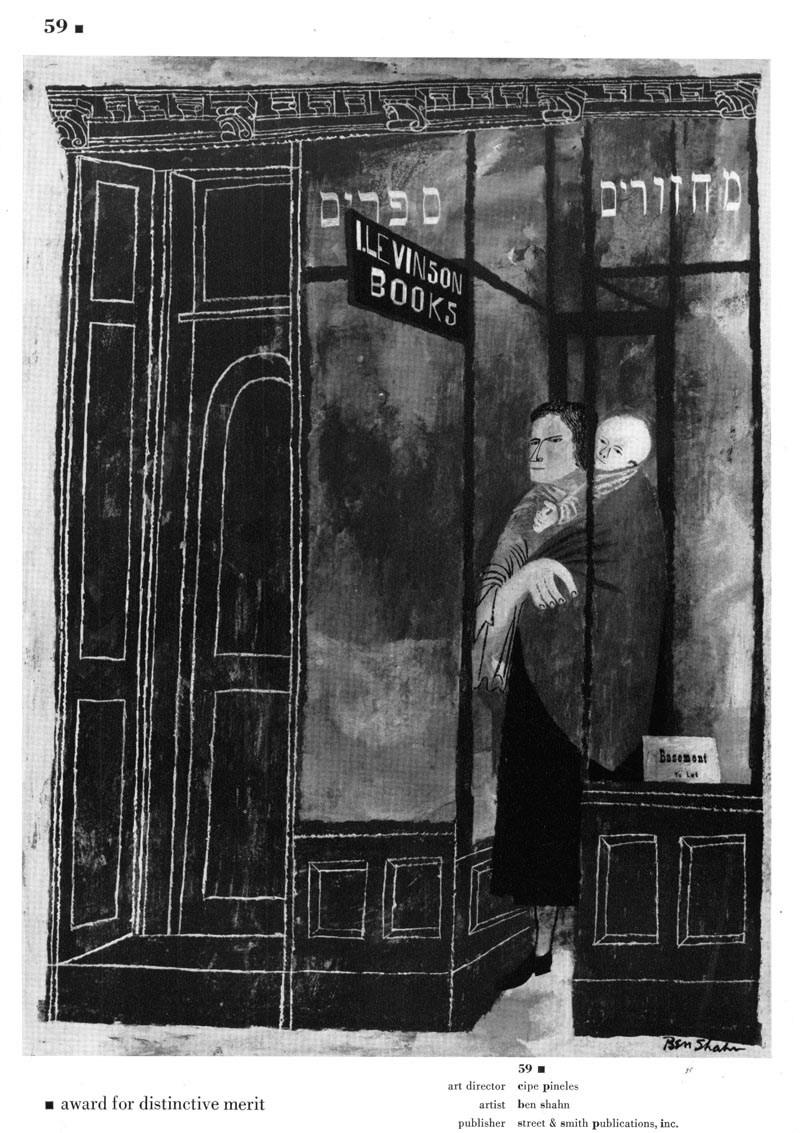
At least one commenter from last week would counter Tom's assertions by saying that Shahn was many things - but he was not an illustrator - therefore he was not bound by the implied standards of professional conduct expected of the commercial artist. Personally, I reject the notion that Shahn was not an illustrator (and if he was, so what?).

As a visual communicator, the illustrator's job is to use his creativity to solve a client's communications challenges. That process often means undertaking work where one's own creativity takes a back seat to the client's needs and wishes. Although I'm sure Ben Shahn was selective about many of the assignments he chose to work on, he was not above doing work that asked little more of him creatively than his distinctive style.
This ad for Fortune magazine's subscription page, for instance...
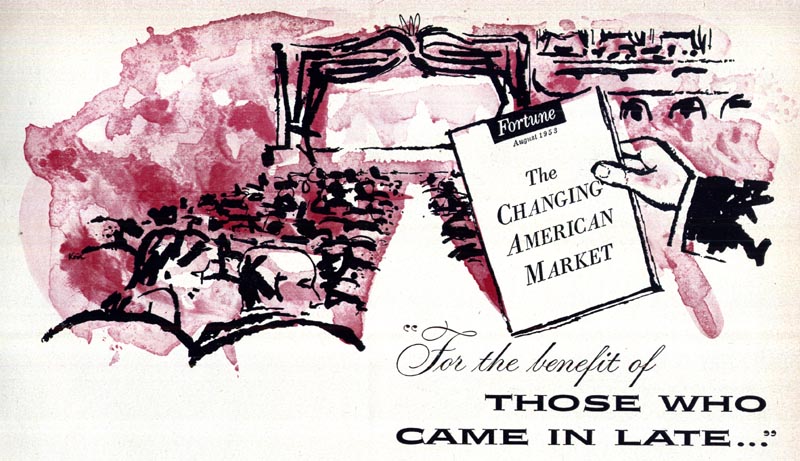
... or this article about business trends in paperback publishing...

... or this DPS ad for the State of Israel, all of which really asked nothing more of Shahn than to decorate the page with appropriate illustrations in his distinctive style.

Shahn's work appeared regularly in trade publication ads for the '50s graphic arts service, Jobs Unlimited, suggesting his relationship with the graphic arts community - the commercial art community - was a sincere one.*
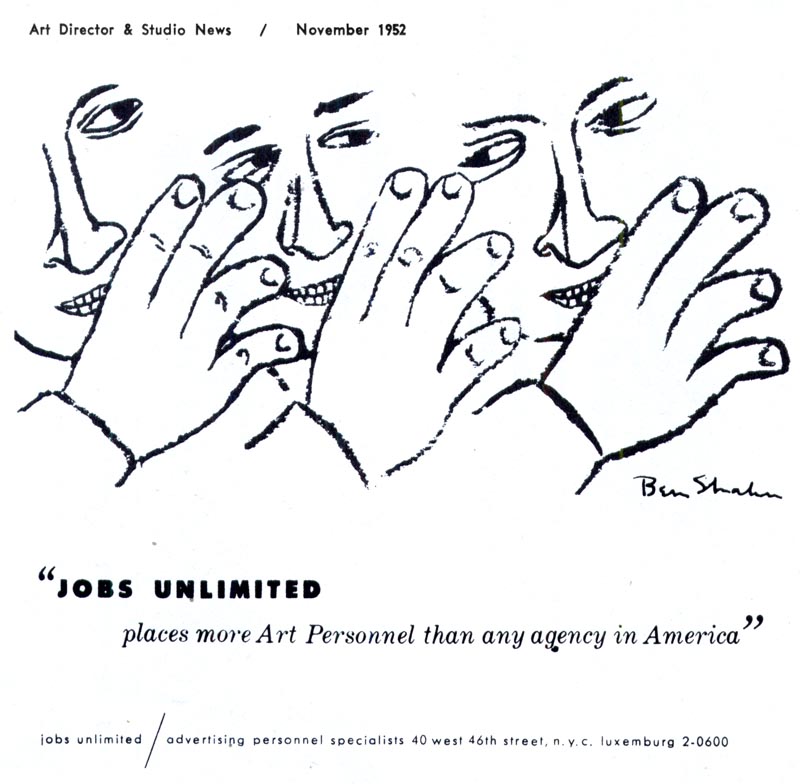
Just a few examples of how Ben Shahn was perfectly willing to provide professional service for payment as a journeyman illustrator and, in so doing, he demonstrated a realistic attitude about his role as a visual communicator (as well as his own brand of stylistic 'realism').
Its a complex subject - and as with so many other aspects of art and picture-making, one that's hard to quantify or to draw definitive conclusions about.

Personally, I believe Ben Shahn 'got' real... the question remains, do you?
* Thanks to Heritage Auctions for the use of the first two scans in today's post.
* Ben Shahn was posthumously inducted into the Society of Illustrators Hall of Fame in 1994.
I'll accept that Shahn was influential, but I just don't see anything particularly innovative in Shahn's work; could someone please point out anything innovative or unique, or is that not what's being argued here?
ReplyDeleteEd; I think you'd need to pour through a pile of magazines from the early '50s to be convinced of how innovative Shahn was. Keep in mind that people were not nearly so overwhelmed by visual clutter back then -- many didn't even have tv sets yet! In that context, magazines were a source of much of the art most people were exposed to - and as I pointed out in today's post, much of that art was within the realm of 'photo-realism.'
ReplyDeleteAdd Ben Shahn to that mix and I think you can begin to imagine why Murray Tinkelman described Shahn as an "emblematic and pivotal illustrator ... responsible for the new look of illustration that started in the 50's."
Leif,
ReplyDeleteI'll sincerely take your word for it that Shahn was innovative for illustration; but wasn't his artistic style very much derived from fine art primitivism? How did it differ from it?
Ed; I'm almost completely ignorant about art history -- hopefully some of our more learned readers will address your question.
ReplyDeleteWhat I'm going on in these two posts on Shahn is based on what I've read and heard personally from illustrators (or their family members) who said that Shahn was THE guy who changed the game. To that I can only add what I see in my old magazine collection which is, I think, fairly extensive.
I think the one undeniable thing about Shahn was that he was an excellent graphic communicator.
ReplyDeleteA question arises then... are all excellent graphic communicators illustrators? Or are they graphic designers?
Or maybe we can back it all up and ask, are all graphic designers illustrators?
It becomes evident that during the 40s and 50s as the illustration field fell from the imaginative heights of the golden age to a highly photo-referenced professionalism, there was a reaction that blurred the lines between realism and cartoon/graphic designing.
Then again, colorspace is continuous in all directions, yet we can pick out blue from green. Categories such as Graphic Design, Illustration, or Fine Art may exists, but without stark boundaries.
Great posts, Leif..
kev
I'll be damned - beaten to the punch again! Thank you, Kev, for that terrific, insightful comment. (I wish I was going to have put it as succinctly and eloquently but nevertheless...) Yes, you nailed it... the rise of the illustrator/designer was going to be my next post.
ReplyDeleteWill be my next post, that is. ;^)
David Roach sent the following by email and gave me permission to c&p it here. David wrote:
ReplyDeleteCy Twombley has just died so it’s perhaps a good time to consider how he, Shahn and Rockwell are regarded. Twombley is absolutely fine art- could we even say high art?- exhibited in galleries and museums. Shahn is perhaps a fine art illustrator in that he’s essentially a fine artist working in the commercial world. He would fit very nicely in the fine art world if he were better known but he’s a very obscure outside of our sphere of interest. Plus in the gallery context I’m not sure he’d be considered that original a figure, certainly not the innovator that he was in illustration. Rockwell is an illustrator pure and simple- and would be particularly thought so as such from the 50s on if compared to abstract impressionists or Pop artists.
But- throw away the labels, ignore context and imagine what people will think in, say, 50 years time, how will things stand then? Twombly is to some degree drawing upon illustrative iconography- graphiti images, calligraphy etc.; it’s all about mark making and colour. I could be wrong, but in a way you can only invent, or in this case deconstruct, the wheel once and in retrospect will there be much to differentiate his work from so many others of his ilk. I wonder if the likes of Phillip Guston or Jean Michel Basquiat which are slightly more conventionally image based might engage the public a little more. If Shahn will be remembered at all I’m not sure he’ll stand the comparison well; too demanding for the typical illustration fan, not original enough for the fine art crowd. In 50 years time will we even be thinking of Rockwell in the same terms of Shahn? Earlier this year I saw a major exhibition of his work in the Dulwich Gallery in London where he was surrounded by the likes of Vermeer, Boucher and Gainsborough and at his best I felt the comparison was a very positive one, he really didn’t seem out of place at all.
So if Rockwell is an illustrator now, will this term even mean anything in 50 years time? He himself made the comparison with Jackson Pollock but might he in fact be seen as a 20th century Vermeer? Shahn might be lauded or completely forgotten- it’s hard to say and Twombley? I suspect he’ll be a fixture of all the major museums but perhaps not the major figure he is now. In the collections but perhaps not necessarily on show.
What do you think?
This posts worth a read. In fact I just discovered this author, and I think his vision is a very very interesting one.
ReplyDelete"Realism" have, as Shahn said, a lot of definitions. Its apparent to me, that Shahn have, at least, a very strong conviction about what he see, and how he feels about that. And that's the most strong reason of why is art is valuable.
This author, in fact, reminds me another artist of the same period, but a graphic designer. His name was Paul Rand, and, as Steve Jobs described his work: "His work is very emotional, but when you study it, is very intelectual".
At first sigh, its apparent to me that his artwork have that exact qualities. (A rare thing :p )
I think the best way to understand the differences between fine art and commercial art is making a comparison between Edward Hopper's and Rockwell's work, more than the one between Shahn and N. R.
ReplyDelete(Shahn, O.K. But what about Saul Steinberg? Who comes first in time?)
I find the graphic design comparison to be very useful in understanding Shahn's work.'Maximum communication, minimum means' is the adage and his work satifies this description.
ReplyDeleteBut that is not the sole function of illustration. Illustrators may also be storytellers or decorators.From a personal point of view I think the craft of illustration ultimately did not benefit from the growing Shahn influence thru the 50s and into the 60s.I know its a cynical view but it takes a lot less time and effort to produce a spindly 'committed' line drawing plus you get to look cool in the process.I can see why a lot of illustrators would find that a nice idea.
That's an interesting point, Adam. On the one hand, I think many illustrators found it appealing because it offered a new direction, in terms of style and technique, in which to express themselves. On the other, it offered the benefit of being able to work faster. In a deadline driven profession (and having to compete with the speed at which photographers could deliver visuals to the same client) a style that accelerates the creative process would understandably be VERY appealing to many illustrators.
ReplyDeletethat handball court painting looks at least 20 years ahead of its time (1939 !)
ReplyDeleteThanks for posting the full article. Great insights about realism, definitions in general, etc. It is odd to me that when people express points of view through their work that are different than the "norm" that the work is often picked apart and criticized for aesthetic and surface choices.
ReplyDeleteI don't really have it in me to criticize work for how it is done, the look of it, etc. I have my tastes, but even when I like the way someone paints, the content has to provoke me in some way. I can respect facility and be bored by the content, or I can be moved by the content despite a lack of finish.
I once heard refinement and originality defined as opposing concepts in a discussion on dialectics. If something is refined, it cannot be original, if something is original, it cannot be refined. Refining is a result of molding an original thing into something related to what one has seen, whether in life, another's interpretation of the same, or a photo. Or even refined based on one's own thoughts. But still, the process of refinement negates the originality of a thing.
To me all the arts are a way to learn about our experience and to see how others perceive the world. As human beings, this ability to share our view is at the core of what we are. I like Ben Shahn's point of view and how he expressed and explored it. Comparisons to what others were doing is irrelevant when looking at an artists work, aren't they?
Yes! The handball court painting looks like Ezra Jack Keats' "The Snowy Day" mashed into the "Eleanor Rigby" sequence in "Yellow Submarine."
ReplyDeleteAnd I see Rockwell's "Abstract and Concrete" in image two. Looking at the two together, uh, illustrates :) to me what Shahn speaks to in his article regarding perspectives in reality.
I'm more familiar with Rockwell's image and always pictured the viewer as being bewildered and a little suspicious about what he is seeing, though he could just as easily be enthralled. "Something is happening here but you don't know what it is. Do you Mr. Jones?"
Shahn's similar image brings to mind the Dylan song as well, where Mr. Jones finds himself no longer a mere observer. His rooftop having been demolished, he is becoming part of the inscrutable fog as well.
I understand the desire to categorize, but I don't see any bright lines here, either. Fine artists or illustrators, realistic or fanciful, the best work takes me someplace else. For real.
Thanks for sharing your perspective, Bill;
ReplyDeleteI can only speak for myself, but comparing and contrasting what different artists were doing during the same period helps me better understand how my profession evolved, who the key players were, and how I fit into the timeline as a graphic artist. It all intrigues me because art has always and continues to play an important role in shaping the culture of society. When I graduated from art school I was ignorant of everything that had come before me in the business - and over the years I've found that studying, comparing and contrasting historically significant art and artists from the mid-century period is something I passionately enjoy and learn from. Does that answer your question?
Mangmade; like Kev Ferrara, you comment anticipates where I'm going next. Stay tuned! ;^)
ReplyDeleteWhen someone is declared or suggested as "the most influential illustrator of the 20th century" or "the greatest living artist", it justifiably invites far more scrutiny than one would normally give. Especially when arguments are based on appeals to the authority of ones favorite artist(s) and the conclusions simply do not pass the eye test.
ReplyDeleteetc, etc; if you're referring to my headline on the first Ben Shahn post, please recall that it had several words after "the most influential illustrator of the 20th century" that did in fact invite scrutiny, yes?
ReplyDeleteMangmade: "Yes! The handball court painting looks like Ezra Jack Keats' "The Snowy Day" mashed into the "Eleanor Rigby" sequence in "Yellow Submarine.""
ReplyDeleteit seems to foreshadow some of Bernie Fuch's later work too.
Leif,
ReplyDeleteYes. My comment was made in response to another comment which suggested that comparisons are irrelevant; I'm simply saying that comparisons are very relevant in the context of declaring "the most" or "the greatest".
Ah! Got it - thanks etc, etc :^)
ReplyDeleteI wish I had something to add this fabulous discussion. But I'm with LawrenceJohn, I'm bowled over by how good those paintings are. Especially the handball court!
ReplyDeleteThat's ok, Adrian -- your appreciation of Shahn's work is comment enough. Thank you! :^)
ReplyDeleteShahn was a master. Greatest illustrator? I don't know. I don't care. What I do know is that he was monumentally influential, and his influence is still being felt today. Look at Edwin Fotheringham channelling David Stone Martin channelling Ben Shahn. I actively ripped off Shahn early in my career. I think it was the one thing Steven Heller actually liked about my work. Maybe the only thing.
ReplyDeleteAdvertising illustration nibbled around the edges of the innovative movement of the 1960s', but it was primarily the editorial illustrations that were in search of and open to whatever new look that art directors thought would attract readership. The smaller amount of off-beat advertising illustration also had to be tempered to communicate the product, service or image of the advertisers.
ReplyDeleteIn retrospect, I think that "looking outside the box" opened doors to some mediocre and even bad quality illustrations during that period. What is successful in the fine art world is generally not that successful in the commercial art world. Those of us in the field of illustration or fine art can talk philosophically all day long about the movements, the isms, the influences and importance, etc., but IMO the bottom line is.. does it communicate the message intended, to the audience targeted? As much as I like some of Ben Shahn's work, they aren't going to seduce or persuade me into reading the story or buying the product or service, just because his art looks more contemporary, or more unique than what came before.
Bernie Fuchs and some others, utilized some Shahnism, and other fine artists, and they found great success with it. Why? Because they tempered it to function effectively in the world of advertising, editorial and book illustration. Even Robert Weaver's figures were usually a little more academic than Shahn's.
Illustration and design students seemed to have missed that point sometime after the 1970s', and art directors began complaining to art schools and veterans like myself, that many of the illustration, design and art director graduates, were not equipped to do the jobs that needed filling. They lacked an education and understanding needed on a daily basis in the commercial art field. Hence, myself and others that were schooled prior to the 1970s', were offered part time jobs teaching comprehensive drawing and TV storyboard illustration at the Academy of Art College in S.F.
The unique Ben Shahn look and others like him, was very limited in where they fit into the commercial art world. They won awards at the AD and Illustration shows, but that can also be deceptive to young art students. Mixing the fine art look with the commercial art look can be very effective, if the art school, the illustrator and the AD do not take their eye off the ball.
Tom Watson
Yes, I "get real" much in the way Shahn did, according to his article (and thanks for sharing that.) I also get "fashion," and how artists like Shahn could suddenly be the new black, at least for awhile. Once a style is created and then mimicked, it's no longer new or fresh. Shahn's work, although I enjoy it, still looks very dated to me.
ReplyDeleteSpeaking of Real, I don't much care for "reality" TV shows, but they seem to be taking over the airwaves. It just forces me to find my entertainment elsewhere or make my own.
I know I will probably ruffle some feathers, but in reference to Shahns article on what is realism, he implies the Relativism theory in his rational. That is right up there with the argument that reality is actually our dreams, and our dreams are actually our reality. Maybe we can just call all of it "VIRTUAL REALITY" and everyone will be happy. Concluding that there is no conclusive truth to truth, etc., I apparently can neither be right nor wrong in my statements. ;-) All that kind of Bohemian, Beatnik and Hippie coffee shop babble seems to go on forever, only with different players each cycle.
ReplyDeleteTom Watson
Tom; I think you're absolutely correct about one reality: you WILL ruffle some feathers with that comment.
ReplyDeleteLeif,
ReplyDeleteAlthough my last comment was tongue-in-cheek, I do think that society and the art world's non-conformists had their own philosophical points of view, and it was often quite bizarre, except among their ilk, in both art and philosophy. If I were asked to illustrate a realistic tree, I wouldn't hesitate in understanding how I would go about doing it, and I think it would meet most of societies understanding that it is a realistic tree. Apparently Shahn saw it as being more complicated than that. I don't see the benefit in factoring in all the different possibilities of interpretation, unless it is aimed at a specific a specific audience. I think he saw art as a philosophically and visually complicated challenge. That is why his article on "reality" was over analytical and vague, IMO.
Tom Watson
As to my "feathers"
ReplyDelete- I don't feel them ruffled by Tom's down-to-earth comment.
Let's get real;-)